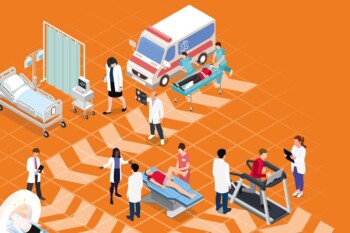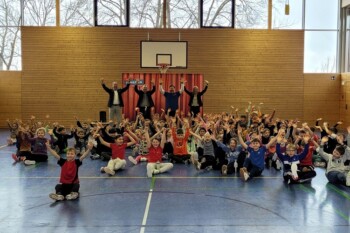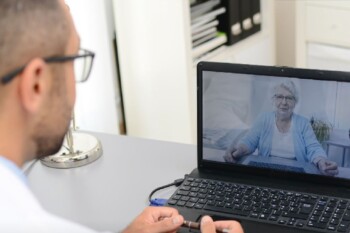Übersetzt aus dem Englischen:
Skoliose ist eine rotatorische Deformität der Wirbelsäule, die zu einer seitlichen Krümmung führt. Wenn sie vor dem 10. Lebensjahr eines Kindes auftritt, wird sie als früh einsetzende Skoliose (EOS) bezeichnet. Dies umfasst die traditionellen Begriffe der infantilen Skoliose in der Altersgruppe von 0-3 Jahren und der juvenilen Skoliose in der Altersgruppe von 3-10 Jahren und spiegelt die unterschiedlichen Behandlungsprinzipien wider, die im Vergleich zur spät einsetzenden Skoliose bei älteren Kindern erforderlich sind.
Es handelt sich um eine seltene Diagnose mit einer Prävalenz von etwa 0,08%. Normalerweise wird sie von den Betreuungspersonen des Kindes oder einem Gesundheitsfachmann identifiziert, der eine Asymmetrie in der Wirbelsäule, ein Ungleichgewicht der Schultern oder ein Sitzungleichgewicht feststellen kann. Die zugrunde liegende Ätiologie kann idiopathisch sein (ohne spezifische Ursache) oder mit neuromuskulären Erkrankungen, syndromaler Skoliose oder angeborenen Abnormalitäten in Verbindung stehen. Sie ist auch mit früheren Eingriffen an der Brustwand verbunden, wie sie bei angeborenen Herzerkrankungen vorkommen können. Nach der Identifizierung wird sie über Jahre hinweg auf etwaige Fortschritte überwacht und entsprechend behandelt. Die Behandlung hängt von der Lage und dem Ausmaß der Krümmung, der Progressionsrate, der zugrunde liegenden Ätiologie, den medizinischen Begleiterkrankungen sowie den Wünschen des Patienten und seiner Familie ab. Obwohl die meisten EOS-Krümmungen konservativ behandelt werden, erfordern einige progressive Krümmungen möglicherweise eine Gipsjacke, eine Stützvorrichtung oder eine Operation.
Die häufigste Operation für Skoliose bei älteren Kindern besteht darin, eine hintere Skoliosekorrektur mit Fusion der Wirbelsäule durchzuführen. Bei Kindern mit früh einsetzender Skoliose entwickelt sich die Brust jedoch noch, und eine Fusion könnte zu einer geringeren thorakalen Höhe führen, was mit Atemproblemen und einem erhöhten Risiko für vorzeitigen Tod verbunden sein kann; dies wird als Thoracic Insufficiency Syndrome bezeichnet. Alveolen entwickeln sich bis zum 7. Lebensjahr und hypertrophieren danach. Die Aufrechterhaltung der Compliance der Brustwand und die Maximierung der thorakalen Höhe während dieser Phase des frühen Wachstums müssen gegen die Kontrolle einer progressiven Skoliose abgewogen werden, um Langzeitbeeinträchtigungen zu reduzieren.
Um weiteres Wachstum zu ermöglichen und gleichzeitig die Skoliose zu kontrollieren, wurden “wachstumsfreundliche” Implantatsysteme entwickelt. Diese können auf Ablenkung, Kompression oder Wachstumsführung basieren, und die Details dazu werden später in dieser Technik diskutiert. Der hier behandelte Patient hat Ablenkungs-basierte wachsende Stäbe eingesetzt; Beispiele für diese Methode sind traditionelle Wachstumsstäbe und magnetgesteuerte wachsende Stäbe. Schrauben (oder Haken) werden am kranialen und kaudalen Ende der Deformität eingesetzt, und Stäbe werden dann zwischen ihnen eingesetzt. Mit dem Einsetzen der Stäbe wird eine teilweise Korrektur der Skoliose erreicht, aber der Patient muss alle sechs Monate für die routinemäßige Verlängerung der Stäbe in den Operationssaal zurückkehren, da sie weiter wachsen. Da die Stäbe einen beweglichen Abschnitt der Wirbelsäule überspannen, gibt es eine viel höhere Komplikationsrate bei der Verwendung von wachsenden Stäben im Vergleich zu einer Fusionsprozedur. Diese kann Stabbruch, Lockerung von Schrauben oder Haken oder auch eine junctionale Kyphose und andere Deformitäten umfassen. Da die Komplikationsrate mit der Dauer zunimmt, die die Implantate an Ort und Stelle sind, ist es wichtig, eine Operation so lange wie möglich zu vermeiden und sicherzustellen, dass alle nicht-operativen Maßnahmen angewendet wurden. Sobald das Kind eine zufriedenstellende thorakale Höhe erreicht hat
Original Intro:
Scoliosis: Insertion of spinal traditional growing rods( Globus Marvel growing rod system) for early onset scoliosis
Mr Stephen Morris FRCS (Tr & Orth).
Avon Orthopaedic Centre, Southmead Hospital, Bristol
Scoliosis is a rotational deformity of the spine resulting in a lateral curvature. If it occurs before a child is 10 years old, it is termed early onset scoliosis (EOS). This incorporates the traditional terms of infantile scoliosis in 0-3 yrs old age group and juvenile scoliosis in 3-10 yrs old, and reflects the different management principles required to treat it when compared to late onset scoliosis in older children.
It is an uncommon diagnosis with a prevalence of around 0.08%. It will normally be identified by the child’s carers or a healthcare professional who may find an asymmetry in the spine, shoulder imbalance or sitting imbalance. The underlying aetiology may be idiopathic (no specific cause) or can be related to neuromuscular conditions, syndromal scoliosis or congenital abnormalities. It is also associated with previous surgery involving the chest wall, such as for congenital cardiac disease. Once identified, it is monitored over the course of years for any progression, and treated accordingly. Treatment will depend on the location and magnitude of the curve, rate of progression, underlying aetiology, medical co-morbidities and the wishes of the patient and their family. Whilst most EOS curves are treated conservatively, some progressive curves will require plaster jacket, brace therapy or surgery.
The most common operation for scoliosis in older children is to perform a posterior scoliosis correction with fusion of the spine. However, in children with early onset scoliosis, the chest is still developing and performing a fusion operation could result in a smaller thoracic height which can be associated with respiratory impairment and risk of premature death; this is called thoracic insufficiency syndrome. Alveoli are known to develop until 7 yrs old, then hypertrophy thereafter. Maintaining chest wall compliance and maximising the thoracic height during this period of early growth must be balanced against controlling a progressive scoliosis in order to reduce long-term disability.
In order to allow ongoing growth whilst controlling the scoliosis, ‘growth-friendly’ implant systems have been developed. These can be distraction-based, compression-based, or growth-guidance and the details of these are discussed later in this technique. The patient involved here has distraction-based growing rods inserted; examples of this type of method include traditional growth rods and magnetically-controlled growing rods. Screws (or hooks) are inserted at the cranial and caudal extent of the deformity and rods then inserted between them. As the rods are inserted, a partial correction of the scoliosis is achieved but the patient does need to return to the operating theatre every six months for routine lengthening of the rods as they continue to grow. Since the rods are spanning a mobile section of the spine, there is a much higher complication rate using growing rods than following a fusion procedure; this could include rod breakage, screw or hook loosening, or junctional kyphosis and other deformity. Since the complication rate will increase with duration of time that the implants have been in situ, it is important to attempt to avoid surgery until they are as old as possible and ensure all non-operative measures have been used. Once the child has grown to a satisfactory thoracic height, the growing construct can be revised to a definitive scoliosis fusion (or scoliosis correction) which will then stop that section of the spine changing position or growing; they would normally need to be at least 9 years old to have achieved sufficient height.
OrthOracle readers will also find the following instructional operative techniques of interest:
Scoliosis correction(neuromuscular): Anterior release and apical corpectomy
EDF(Elongation-Derotation-Flexion)/Mehta casting for Early Onset Scoliosis
T11 to L3 anterior scoliosis correction and fusion with the Globus Anterior Staple System
Anterior release of scoliosis (access by thoracotomy)








